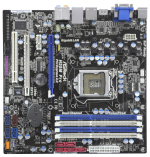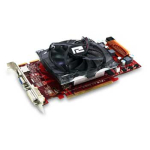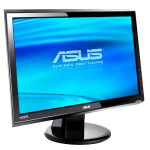System Buyers' Guide: PCs for Under $1000
by Sean Hollister on February 12, 2010 2:00 AM EST- Posted in
- Guides
Intel Mainstream PC
If you have a bit more to spend, the next step up the pricing ladder brings a lot to the table: the Intel Core i3-530, a best-in-class H55 motherboard, a 1080p LCD monitor and a bang-for-the-buck GPU to power it. Now we're talking.
| Intel Mainstream System | ||
| Hardware | Component | Price |
| Processor | Intel Core i3-530 (2.93GHz x2, 32nm, 4MB L3 Cache) |
$120 |
| Cooling | CPU Retail HSF | $0 |
| Video | PowerColor Radeon HD 4850 512MB | $100 |
| Motherboard | ASRock H55M Pro LGA1156 Micro ATX | $95 |
| Memory | G.Skill Ripjaws 4GB DDR3-1600 F3-12800CL9D-4GBRL | $105 |
| Hard Drive | WD Caviar Blue 500GB WD5000AAKS | $54 |
| Optical Drive | Sony Optiarc Model AD-7240S-OB 24X DVDRW SATA | $28 |
| Audio | Onboard | $0 |
| Case | Cooler Master Centurion 5 CAC-T05-UW Mid Tower ATX | $55 |
| Power Supply | OCZ ModXStream Pro 500W ATX12V SLI Certified, CrossFire Ready, 80 PLUS Certified Modular Active PFC (before $25 Rebate) | $65 |
| Base System Total | $622 | |
| Display | ASUS VH226H Black 21.5" 2ms(GTG) HDMI Widescreen 16:9 LCD (1920x1080) (before $20 Rebate) | $170 |
| Speakers | Cyber Acoustics CA-3090 26W 2.1 Speakers | $21 |
| Input | Microsoft B2L-00045 Comfort Curve Black USB Keyboard and Optical USB Mouse - OEM | $22 |
| Operating System | Microsoft Windows 7 Home Premium OEM 1-Pack (for System Builders) | $105 |
| Complete System Bottom Line | $940 | |
| Plus Estimated Shipping (within Continental U.S.) | $990 | |
| Rebates | -$45 | |
| Bottom Line (less tax, if applicable) | $945 | |
Though its price and associated requirements (LGA1156, DDR3) make it prohibitively expensive for entry-level rigs, we fully expect the Core i3-530 to be the starting point for bang-for-the-buck PC building guides around the globe anyhow. That's because at only $125, the Core i3-530 is not only the fastest dual-core processor available today, but also—with two logical threads per core—performs on par with the best budget quad-cores in most benchmarks. If that weren't enough, it features an on-die integrated graphics solution that rivals the best IGPs AMD has to offer (which isn't saying much, sadly) and it does it all while consuming less power than practically any other mainstream CPU out there. And thanks to its 32nm process and a 22x multiplier, it also overclocks to 4GHz using the stock cooler (YMMV).
 |
Paired with this Clarksdale wunderkind is the ASRock H55M Pro, the best, least-finicky H55 motherboard we've yet tested. Featuring the onboard VGA, DVI and HDMI video-out connectors and Flexible Display Interface needed to make use of the Core i3's Intel HD IGP, the board also features a superb layout. It has a pair of PCIe x16 slots (one at x16, one at x4), a PCIe x1 and a PCI slot arranged in a configuration where none of its ports are liable to be covered by expansion cards. Speaking of ports, the board comes with five neatly arranged SATA 3GB/s ports on the board and three USB 2.0 headers, with an eSATA, six USB2.0 ports, a combo PS/2, a single 1394a and optical S/PDIF out on the rear panel. 7.1 channel HD audio duties fall to the VIA VT1718S, while a Realtek 8111DL handles Gigabit Ethernet. There's even a TPM header.
While the board supports all current LGA 1156 Core i7, i5 and i3 processors, up to 16GB of DDR3-2600 memory and even Quad CrossFireX, it's not really a board you'd slot premium DIMMs or multiple GPUs into. We found it to have only moderate overclocking potential, and the PCIe x4 puts the kibosh on even regular CrossFire giving you your money's worth. But for $95, it's a wonderful board on which to build a mainstream PC.
 |
Given the fidelity of the onboard Intel HD Graphics, and assuming you don't care to play modern games in excess of 1024x768 resolution at minimum settings, a dedicated graphics card is honestly quite optional in a Core i3 and H55-equipped mainstream PC. Even without it, you can bitstream Dolby TrueHD and DTS HD-MA over the HDMI connection, handle hardware accelerated decoding of H.264/VC-1/MPEG2 streams, and drive large desktop screens. But because last year's mainstream rig included our editor-favorite Radeon HD 4770, it was hard to pass up the even more powerful, game-crunching $100 Radeon HD 4850. If you'd rather, you can get the slower Radeon HD 5670 for the same price and have access to DX11, Eyefinity and possibly 3D Blu-ray support later this year, or add $40 and get the best of both worlds with the faster Radeon HD 5750 1GB. Alternatively, you can save the $100, or put it towards one of the other goodies in our upgrade list on page 6. But know that when we were looking for a video card with enough value to automatically deserve a place in our mainstream rig, we immediately gravitated towards the 4850.
 |
While all other base components are the same known quantities we used for our entry-level rigs, we upgraded two peripherals for our mainstream PCs that deserve mention here. First, because in-monitor speakers are notorious for their low quality, we bring back last year's Cyber Acoustics CA-3090 2.1 speaker system, a fantastic value even at $20 (compared with $16, nine months ago). Second, we upgraded the LCD monitor to the ASUS VH226H. At $150 after rebate, the VH226H offers far more than $30 worth of extra value over the $120 VW193TR it replaces: it's a 21.5", 1920x1080 TN panel with a 2ms grey-to-grey response time, 1000:1 typical contrast ratio, and the all-important HDMI 1.3 input jack alongside standard DVI and VGA.










86 Comments
View All Comments
jstall - Tuesday, February 16, 2010 - link
While I have no problems with Dell LCD monitors (some great buys and I own 2) I would never again purchase a Dell system. Poor build quality, poor components and limited life. I would rather take the extra time and effort to build a system knowing the parts were carefully chosen/thought out and well put together.
Just because it's a budget system doesn't mean you can't think and act like it's a high end system when you put it together. After all, this may be someone else's high end system when it's built.
StormyParis - Friday, February 12, 2010 - link
Thanks for yet another very nice write up. I use them regularly when recommending or buying PCs.A few suggestions:
1- the perfomance graphs are very nice. Could you possibly
1a- generalize them, so that we can see how much the extra money spent going from "entry" to "mainstream" buys us, performance-wise ?
1b- indeed, include your past recommended configs, so that we can judge if upgrading is worth it.
1c- format the graphs as indexes, I got a headache mentally flipping half of the bars.
1d- to make up for all that extra work, methinks you could get rid of a handful of benches, and just keep 1 each of: boot+launch apps, DX9 game, DX10 game, video encode, office work.
2- You seem in love with Asus MBs. I've given up on them after a couple of dead MBs, and very bad service. My retailer told me that the issue was frequent, on top of that. I do like Asus's screens a lot though, much better build than most others.
3- It would be nice to have upgrade suggestions, as in "how to best spend an extra 10%"
4- Maybe you could list the peripherals (screen, kb+mouse, printer...) separately ?
Anywyay, those are minor remarks. Thanks and congrats on a job well done.
Olivier
JarredWalton - Friday, February 12, 2010 - link
Thanks for the feedback.Are you referring to ASUS or ASRock? We've got one ASUS, two ASRock (a split off from ASUS back in the day, but I'm sure we can all agree that they're not the same sort of company, given the sometimes quirky nature of ASRock board layouts), and one Gigabyte. So one of four is hardly too many ASUS boards.
All manufacturers have some poor products, and most of these recommendations are made with input from our other editors. The ASRock H55 board for example is the best current bang-for-the-buck that Raja has tested. General statements about ASUS quality (or any other brand) being good or bad don't help unless you've had actual experience with the recommended board.
For upgrades, we've got page six... though I suppose we didn't specifically address the 10% extra? Separating out peripherals is something we will likely do in future guides.
GeorgeH - Friday, February 12, 2010 - link
Overall the article was well done, but there’s a lot of room for improvement in its organization.The RAM, HDD, Case, PSU, KB/Mouse, and OS are common to all builds, so it would have been good to do a first page breaking out and detailing all of those items, and to only list them once. The following page could then have been dedicated solely to unique Entry-Level components, and the one following that to unique Mainstream components (although if there were room, both Entry-Level and Mainstream on the same page would be even better.) Also slightly better highlighting (perhaps a different color or slightly larger font) of the most important totals would help immensely.
As it stands right now, it’s very difficult to get a sense of the differences between the builds without lots of clicking back and forth and/or the opening of multiple windows, meaning a lot of the (very good) information you have to offer here just gets lost in the work of trying to sift it out.
BelardA - Friday, February 12, 2010 - link
Yep... the now discontinued X2 550 (and X3 720BE) is defaulted at 3.1ghz. With air and no voltage changes... it runs like a champ with all 4 cores running and 3.4ghz. Some are hitting 3.6~3.8 without raising the voltage on the x2 550.X2 555 = 3.2ghz default clock. About $10~15 more in price.
These CPUs are usually faster for day to day operations over the X3... getting the other 2 cores up and running is a big plus.
Gigabyte boards have the BIOS setting for this... takes seconds to do.
AznBoi36 - Friday, February 12, 2010 - link
For a HTPC case, check out the Moneual Labs MonCaso 312 HTPC case.http://moneual.cafe24.com/english/sub02/sub6.htm">http://moneual.cafe24.com/english/sub02/sub6.htm
It's a beauty.
jstall - Friday, February 12, 2010 - link
Nicely done and welcome, I think we often forget that some of the systems we build are not mainstream. I may even put together the budget AMD system in the next month or two.
Thanks for a well thought out article.
JarredWalton - Friday, February 12, 2010 - link
Congrats to Sean on his pilot article for AnandTech!Just FYI, if you try to send him an email, you'll notice that it goes to me instead. I'll forward the email messages on to him short term, because we don't want to overwhelm Sean's real email with hundreds of spam messages.(After heavy filtering, I still get at least 10-15 spam messages per day... and when we switched filtering a few years back and didn't have anything for a day or two, there were 2000+ messages in just one day. Ouch!) Update: We're going to see how Gmail does at filtering spam now, per Sean's request. So now you can flame him without me filtering anything. ;-)Anyway, long story short, you can either email Sean through me, or you can leave him a comment down here and we all get to see it. So welcome aboard, Sean, and good job with your first article.
coolhardware - Friday, February 12, 2010 - link
Very nice article Sean!I always enjoy seeing Anandtech put their expertise to use in creating some nice builds :-).
I was a bit worried that the entry level AMD system I put together a couple of weeks ago, http://bit.ly/b6GF9W">http://bit.ly/b6GF9W was already going to be obsolete ;-). It looks like it is holding its own though. That system was inspired by Anand's Phenom II X2 unlocking article. Any tweak/tips from other readers are greatly appreciated.
Please keep up the great work guys!
Rampage1 - Friday, February 12, 2010 - link
I'm not sure why most hardware sites segregate their reviews for processors
AMD processors
Intel processors
why not just processors?
and specify price/performance etc